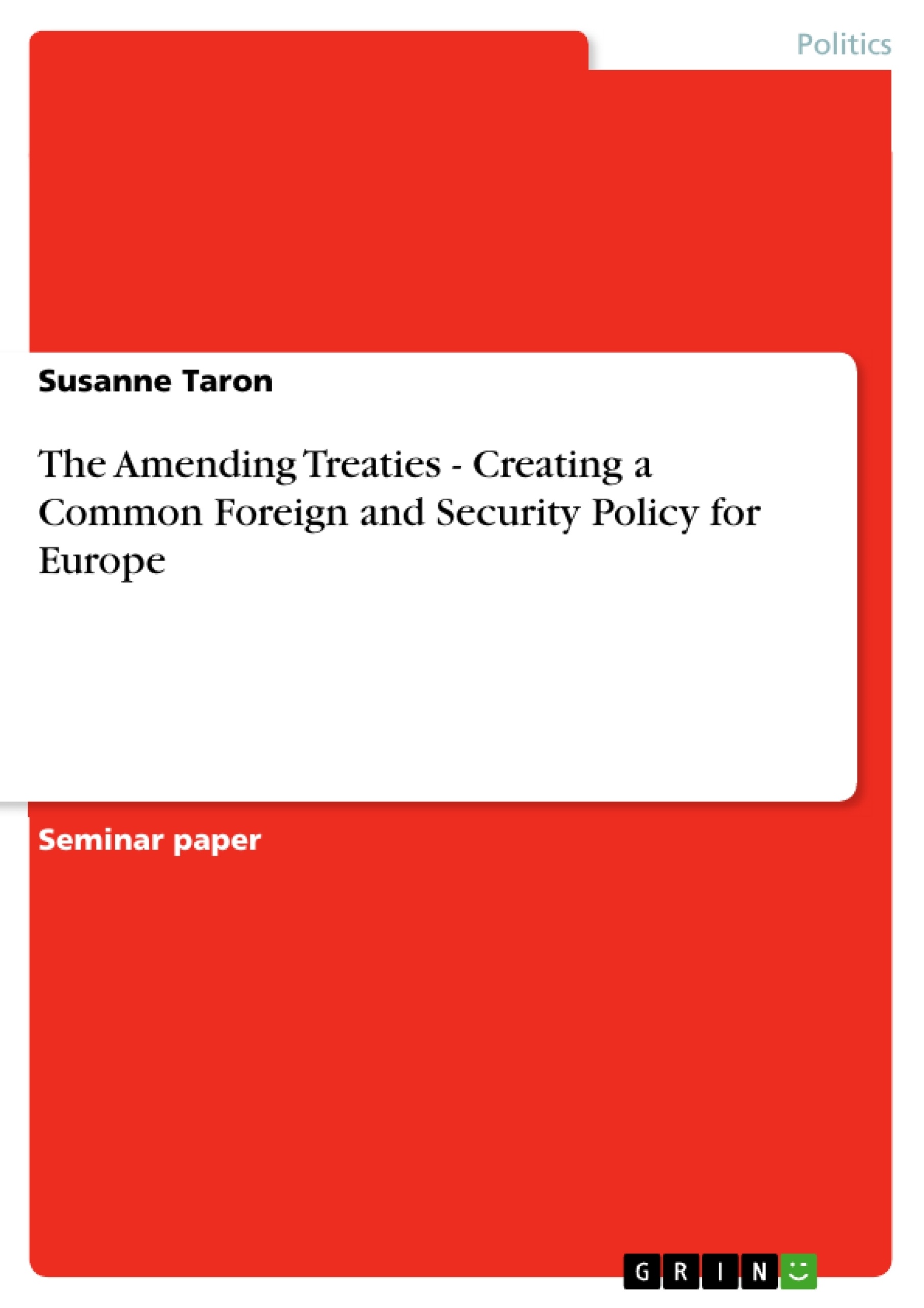Excerpt
Table of Contents
List of Abbreviations
1. Introduction
2. The legalization of European foreign policy
3. From the emergence of the EPC to the SEA: European foreign policy as a legal regime
A. Evolution of European Political Cooperation
B. The Single European Act
4. The Treaty of Maastricht and the establishment of CFSP
5. The Amsterdam Treaty and reform of CFSP
6. CFSP provisions under the Treaty of Nice
7. The possibility of future CFSP reform: the Constitutional Treaty
8. Conclusion
Bibliography
List of Abbreviations
illustration not visible in this excerpt
1. Introduction
The European Union today represents undeniably one of the most unusual yet comprehensible political actors in the in the international system. Since the early wake of the 1950s, its capacity has gradually expanded to encompass foreign policy initiatives, ranging from a vast array of foreign policy tools including economic, diplomatic, and now to a very limited extent military operations related to peacekeeping and peace enforcement. This capacity, however, was neither included in the original Treaty of Rome, nor was it predicted by the many observers of European integration. Indeed, when the Treaty establishing the European Economic Community (EEC) was first signed in 1957, the predominant political philosophy held at the time was driven by the deduction that European market integration would bring untrammelled economic growth and prosperity to the region, and that consequently armed conflict which had evidently plagued the European continent for over half a century prior to the conclusion of the Second World War, would become an event of the past. Certainly at this time, no mention was given to the fact that European economic strength should and would translate over into greater foreign policy influence in the international system. While admittedly there were attempts to create a European foreign policy involving the member states of the European Community (EC) which had predated the EEC under the Treaty of Rome, namely the Gasperi initiative of 1952.[1] Such attempts would accompany the ill-fated endeavour to create a European Defence Community under the original six members of the ECSC which had blatantly floundered. Indeed, member states of the EC would have to wait until the 1970s before they could engage in a process of foreign policy cooperation under the European Political Cooperation (EPC) of 1970, in of which, would subsequently become legalized under the Single European Act of 1987.[2]
New threats and new requirements concomitant to the rapid geopolitical changes that had transpired from post-Cold War disarticulation would ultimately abet the EPC to elapse under the ratification of the Maastricht Treaty (TEU). Entering into force on November 1, 1993, the TEU provided the EU with new and enhanced competencies, one of which would be the Common Foreign and Security Policy (CFSP) which would be representative of the second intergovernmental pillar of the EU's architecture.[3] Indeed, by providing the EU with a solely one voice on the international stage, the CFSP has irrefutably endeavoured under Article 11 of the TEU to strengthen and safeguard the fundamental values and principles underlying the Union, whist additionally promoting international peace, cooperation and security.[4] Nonetheless, after thirteen years of its existence, the CFSP today has not remained a static body; in fact it has continually been revised under the amending treaties, in a true attempt to enhance its institutional framework and to advance a stronger and more credible European voice in the global arena.
It is with this very notion in mind that one is ostensibly reminded that the European Union is a continually evolving entity. Nearly fifty years have passed since the founding treaties were established, and within this timeframe the EU has unremittingly been shaped and reshaped by a number of provisions evident in the amending treaties. Indeed, each new treaty has amended its predecessor, which when taken together has defined the basic principles and objectives under which the Union and its institutions fundamentally operate.[5] From the Treaty of Rome in 1957 to the draft Constitutional Treaty of 2004, the European Union indeed provides adequate substantiation to the classical dictum “Rome was not built in a day”, where likewise the progress of European integration has been a gradual and evolving process.
Against this very background, and throughout this rather prolonged introduction, the purpose of this paper will attempt to reveal that the evolution and advancement of a European foreign policy has taken place through a course of amendments evident to the treaties, in of which have considerably altered and enhanced the competencies of this policy area. Thus, in an evolutionary process that saw its beginnings nearly thirty-five years ago, the EU has created itself a stronger foreign policy dimension that has seemingly paralleled its international role as a major commercial and economic power. This process however, has not been effortless, nor has it been devoid of its criticisms. Accordingly, and as this paper will attempt to demonstrate, their remains a continuous and long road ahead for the development of European foreign policy; as it remains far from an immaculate and complete process.
The paper will begin with section two, which offers a brief overview of the characteristics of European foreign policy, with particular reference to the process of legalization. In sections three through six, the paper will outline the development of European foreign policy, beginning with the emergence of EPC to the present form of CFSP under the last amending treaty, that is to say the Treaty of Nice. Section seven will provide insight to the prospect of future CFSP reform under the draft Constitutional Treaty of 2004, succeeded by a final conclusion in section eight.
[...]
[1] Whiteman, 1998, p. 165.
[2] Francia & Abellán, 2004, pp. 124-126.
[3] Hoffman, 2000, p. 191.
[4] Article 11 of the Treaty on European Union (as amended by the Treaty of Amsterdam).
[5] Dears & Hargreaves, 2004, pp. 55-76.
- Quote paper
- Susanne Taron (Author), 2006, The Amending Treaties - Creating a Common Foreign and Security Policy for Europe, Munich, GRIN Verlag, https://www.grin.com/document/64595
Publish now - it's free






















Comments